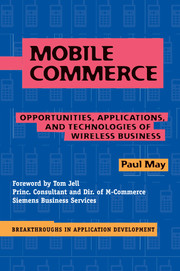2 - Types of Mobile Commerce Services
Published online by Cambridge University Press: 04 August 2010
Summary
This chapter surveys the leading types of mobile commerce services that currently exist or are currently being developed to serve consumer and business user roles. This is not an exhaustive survey. The services chosen for this chapter command the greatest attention amongst users and service providers alike. Each service includes a range of potential associated and follow-on services: indeed, each service could be regarded as an industry in its own right.
We purposely avoid labelling the services as applications. The term “application” implies a demarcated set of functionality designed for a known or ideal user group. Applications are traditionally installed on machines and packaged to fit into the prevailing desktop user interface model. The move towards application service providers (ASPs) in the business world is undermining this traditional concept. An ASP provides the functionality of a software application, such as a human resources application, on a remote usage basis. The customer no longer installs and runs an HR package, dealing with its upgrades and backups. He simply buys the ongoing servicing of his human resources administration needs over a network. An ASP takes on a role similar to that of a large corporation's computing department in the days of time-sharing computers and dumb terminals. The ASP aggregates a number of customers into a virtual organisation and supplies a centralised computing service targeted at common business needs. The ASP movement signals a shift in emphasis from software ownership towards contracted relationships encapsulating service benefits.
- Type
- Chapter
- Information
- Mobile CommerceOpportunities, Applications, and Technologies of Wireless Business, pp. 69 - 160Publisher: Cambridge University PressPrint publication year: 2001



